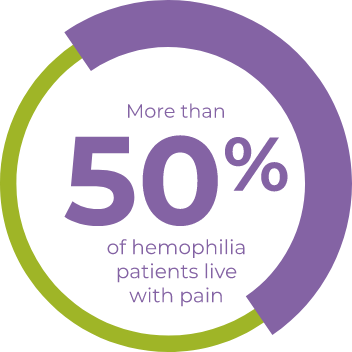Pain is a subjective experience and is unique to each person. The way a person experiences pain is highly variable and can be influenced by several factors. Effective pain management is essential as more than 50% of hemophilia patients have painful joints that cause disability and impair quality of life.

Types Of Pain
Pain is categorized into two types: acute pain and chronic pain. It is important to be able to identify which type of pain you are experiencing as this will help determine the next step to help alleviate it.
Acute pain is often short‑term and can be severe. It is usually a sign that something is wrong. The first step in treating acute pain is to immediately stop using the injured body part and rest it for 24 to 48 hours. When it is associated with bleeding episodes, it should be treated promptly.
Chronic pain is characterized by long‑term discomfort and managed differently than acute pain. Persistent chronic pain, along with other concomitant symptoms, are often associated with chronic synovitis and advanced arthropathy.
How To Communicate Pain To Your Hemophilia Treatment Centre Team
As pain can impact your physical and emotional health, it is important to maintain a close relationship with your comprehensive care team in order for your pain to be managed successfully. Open communication and regular feedback will help the team evaluate your response towards the different treatments to optimize your outcome.

Strategies For Pain Management
Bleed Treatment Prophylaxis & Assessment
Preventing acute bleeds can help with pain management. Prophylactic factor replacement therapy can be used to prevent or reduce the frequency of bleeding episodes. The World Federation of Hemophilia recommends that acute bleeds are treated at home as soon as possible and preferably within 2 hours of onset. Pain that does not improve following an infusion of factor replacement may be due to another cause. Further follow up with a physician may be required.
R.I.C.E
Factor replacement is used for bleed control and reduced pain may result from controlling a bleed. In addition to administering factor replacement, the R.I.C.E. method is also commonly used.
R.I.C.E
Rest and avoid using the injured body part for 24 to 48 hours. A splint or a sling can also be used to limit joint movement and mobility if a bleed is suspected. Continued activity may result in further bleeding, injury, or more pain and discomfort.
Ice can be applied to the affected area in 20‑minute intervals for 48 to 72 hours. This will help constrict blood vessels and reduce pain and swelling.
Compression helps to reduce pain and swelling and prevent further bleeding. Wrap the affected area with a bandage. The bandage should be snug, but not cut off circulation.
Elevation helps reduce swelling. Keep the injured limb raised or elevated as much as possible.
Medications
Medications can be used alone or in adjunct with other treatments to help control pain or reduce swelling. These medications can be obtained over the counter or with a doctor’s prescription. Always consult your hematologist before taking any medication as some pain medications may increase your risk of bleeding.
Physical Therapy
Chronic pain may respond to physical therapy and exercise. Your physiotherapist at the Hemophilia Treatment Centre can assess and design a program specific to your current health status. Exercise programs include components such as flexibility, stretching, and strength.

Orthopedic & Surgical Procedures
Orthopedic or surgical interventions may be considered to manage pain due to recurrent bleeding into a joint despite other treatments.
Procedures such as a synovectomy may help alleviate chronic pain. Removal of the inflamed synovium (lining of the joint) in patients with chronic synovitis can be used to manage recurrent bleeding episodes and permit return of function.
Injection of a corticosteroid (e.g., methylprednisolone) into an affected joint can be used in the short- to medium-term to decrease inflammation and resultant pain.
Chronic pain is typically associated with joint degeneration or other long‑term complications of hemophilia. If less invasive treatments fail to relieve pain, joint replacements may be indicated as a long‑term approach.
Complementary & Alternative Therapies
Complementary and alternative therapies consist of “mind‑body” exercises to help reduce pain. These therapies are often used together with conventional medicine. A variety of methods can be used to help you stay calm and comfortable, such as massage, yoga, acupuncture, music therapy, deep breathing exercises, or speaking to counselors. Always check with your comprehensive care team as some of these alternative therapies may not be completely safe for people with hemophilia.

